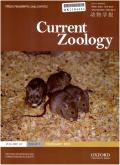Prioritizing landscapes for mitigating the impacts of onshore wind farms on multidimensional waterbird diversity in the Yellow Sea
IF 2
2区 生物学
Q2 ZOOLOGY
引用次数: 0
Abstract
Ongoing wind energy developments play a key role in mitigating the global effects of climate change and the energy crisis; however, they have complex ecological consequences for many flying animals. The Yellow Sea coast is considered as an ecological bottleneck for migratory waterbirds along the East Asian–Australasian flyway (EAAF), and is also an important wind farm base in China. However, the effects of large-scale onshore wind farms along the EAAF on multidimensional waterbird diversity, and how to mitigate these effects, remain unclear. Here we examined how wind farms and their surrounding landscapes affected multidimensional waterbird diversity along the Yellow Sea coast. Taxonomic, functional, and phylogenetic diversity of the waterbird assemblages, and mean pairwise distances and nearest taxon distances with null models were quantified in relation to four different wind turbine densities. We also measured six landscape variables. Multi-dimensional waterbird diversity (taxonomic, functional, and phylogenetic diversity) significantly decreased with increasing wind turbine density. Functional and phylogenetic structures tended to be clustered in waterbird communities, and environmental filtering drove waterbird community assemblages. Furthermore, waterbird diversity was regulated by a combination of wind turbine density and landscape variables, with edge density of aquaculture ponds, in addition to wind turbine density, having the greatest independent contribution to waterbird diversity. These results suggest that attempts to mitigate the impact of wind farms on waterbird diversity could involve the landscape transformation of wind farm regions, e.g., by including high-edge-density aquaculture ponds (i.e. industrial ponds) around wind farms, instead of traditional low-edge-density aquaculture ponds.为减轻陆上风电场对黄海多维水鸟多样性的影响确定景观优先次序
正在进行的风能开发在缓解全球气候变化影响和能源危机方面发挥着关键作用;然而,它们对许多飞行动物造成了复杂的生态后果。黄海沿岸被认为是东亚-澳大利亚迁徙水鸟(EAAF)的生态瓶颈,也是中国重要的风电场基地。然而,EAAF沿线大规模陆上风电场对水鸟多维多样性的影响以及如何减轻这些影响仍不清楚。在此,我们研究了风电场及其周边景观对黄海沿岸多维水鸟多样性的影响。根据四种不同的风力涡轮机密度,量化了水鸟群落的分类、功能和系统发育多样性,以及平均配对距离和最近分类群距离的空模型。我们还测量了六个景观变量。多维水鸟多样性(分类、功能和系统发育多样性)随着风机密度的增加而显著下降。水鸟群落中的功能和系统发育结构趋于集群,环境过滤驱动着水鸟群落的组合。此外,水鸟多样性受风力涡轮机密度和景观变量的共同影响,除风力涡轮机密度外,水产养殖池塘的边缘密度对水鸟多样性的影响最大。这些结果表明,为减轻风力发电场对水鸟多样性的影响,可以对风力发电场区域进行景观改造,例如在风力发电场周围修建高边缘密度的水产养殖池塘(即工业化池塘),而不是传统的低边缘密度水产养殖池塘。
本文章由计算机程序翻译,如有差异,请以英文原文为准。
求助全文
约1分钟内获得全文
求助全文
来源期刊

Current Zoology
Agricultural and Biological Sciences-Animal Science and Zoology
CiteScore
3.20
自引率
9.10%
发文量
111
审稿时长
6 weeks
期刊介绍:
About the Journal
Current Zoology (formerly Acta Zoologica Sinica, founded in 1935) is an open access, bimonthly, peer-reviewed international journal of zoology. It publishes review articles and research papers in the fields of ecology, evolution and behaviour.
Current Zoology is sponsored by Institute of Zoology, Chinese Academy of Sciences, along with the China Zoological Society.
 求助内容:
求助内容: 应助结果提醒方式:
应助结果提醒方式:


